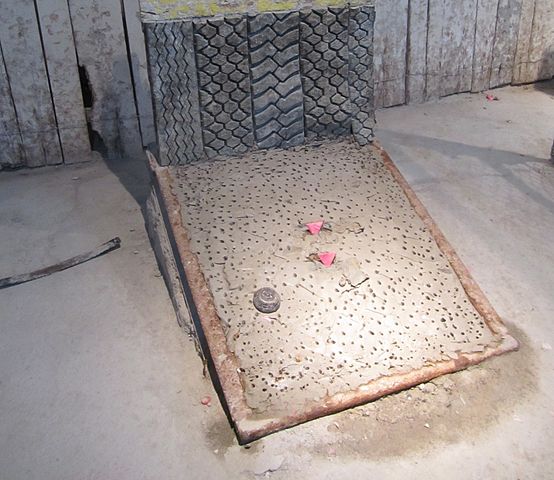
This file is licensed under the Creative Commons Attribution-Share Alike 3.0 Unported license. Author: Lucía Estévez
Tejo is the modern Colombian version of an ancient regional sport called turmequé, both of which involve throwing a small, thick disc (typically made of metal) at a small, triangular target approximately 60 feet away. Tejo is very popular in Colombia today, declared to be the country’s national sport by the Congress of the Republic of Colombia in June of 2000. It’s sport of rich culture, boasting a history spanning back beyond the 15th century in the form of its ancient ancestor. Though the modern rendition has naturally undergone some level of evolution, it is generally believed to be very similar to the ancient game turmequé, with only a few notable differences separating the two. (For example, the original turmequé disks may have been made of solid gold.)
History

This file is licensed under the Creative Commons Attribution 2.0 Generic license. Author: Francisco Osorio
Information on the history of tejo (and, by extension, turmequé) is fairly scant, limited mostly to oral tradition and legends surrounding the sport. These pieces of oral history suggest sensible cultural and economic factors for the sport’s development (such as the introduction of gunpowder pouches via Spanish mining in the 16th century), though these are difficult to verify without written sources.
Turning to the sport’s early history, turmequé was played among the Chibcha people of the valleys surrounding modern-day Bogotá, Colombia prior to Spanish contact in the late 15th century. This nation was one of the foremost in the production and exportation of metal goods, notably those made of gold. This lends credibility to the modern claim that the ancient game of turmequé used disks and triangular targets made of solid gold.
Even after the Spanish conquest of the Chibcha nation in the 16th century, turmequé did not fall out of practice completely, and was apparently adopted into Spanish culture. The sport remained popular at some level throughout the following centuries – of course, undergoing some changes along the way. The gunpowder mecha pouches, for example, were likely introduced to the sport during the Spanish gold-mining in 16th-century Colombia. Though the details of the transition from turmequé to tejo are unknown, the presence of the latter is evidence that this ancient sport has survived in some form for over 500 years.
How to Play

This file is licensed under the Creative Commons Attribution 2.0 Generic license. Author: Neil Taylor
As the fine details of turmequé were not recorded during early Spanish contact, the rules of the modern game are described below.
The goal of tejo is to score points by landing a disk within a metal ring surrounded by small, triangular targets, called mechas. In the modern version of the game, these targets are small pouches filled with gunpowder, which flash and smoke when struck. These pouches sit along the edge of the ring so the thrown disks will ignite them more easily. This ring is a metal cylinder embedded in a clay- or mud-filled trough, buried so that only the circular edge is exposed. The trough is tilted about 30 degrees from the ground toward the player to more easily receive disk.
Variants of the sport introduce teams, scoring mechanics, and other elements. Most variations involve placing more than one gunpowder-filled mecha pouch on the ring, resulting in a greater chance of igniting a pouch. The game is typically played casually, wherein the only competitive aspect is that the loser has to buy the next round of beers. This often results in more relaxed rules, the goal often being to simply ignite a mecha. In more competitive circles, two teams of three players each take turns throwing their disks, and a variety of measuring tools are used to determine which lodged disk scores. (For example, a disk slightly closer to the ring’s center will take the points.)
Equipment
The modern tejo disk is typically made of metal, crafted with a flat bottom and top, with terraced or slanted sides tapering toward the top. Its size can vary slightly, but it is typically made to be about 3 to 4 inches in diameter and around an inch thick. With these dimensions, the disk typically weighs a little more than 2 or 3 pounds. If the ancient version of the sport, turmequé, actually used golden disks, they would have been noticeably heavier.
[raw_html_snippet id=”bib”]
Craig, S. (2002). Sports and games of the ancients. Westport, CT: Greenwood Press.
Morrison, M. (1999). Colombia (Enchantment of the world). Children’s Press.
Learning Tejo in Colombia – Lonely Planet travel video [Video file]. (2010, September 16). Retrieved February 5, 2017.
[raw_html_snippet id=”endbib”]